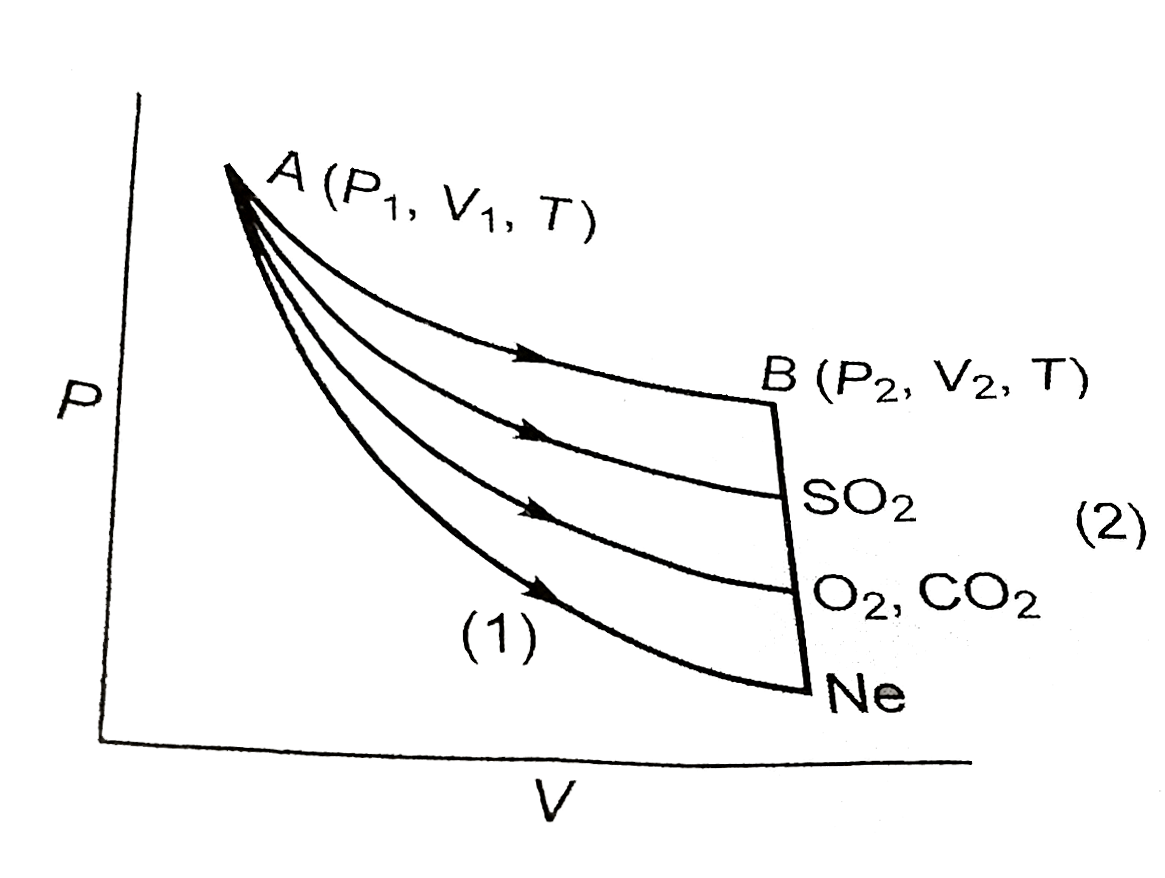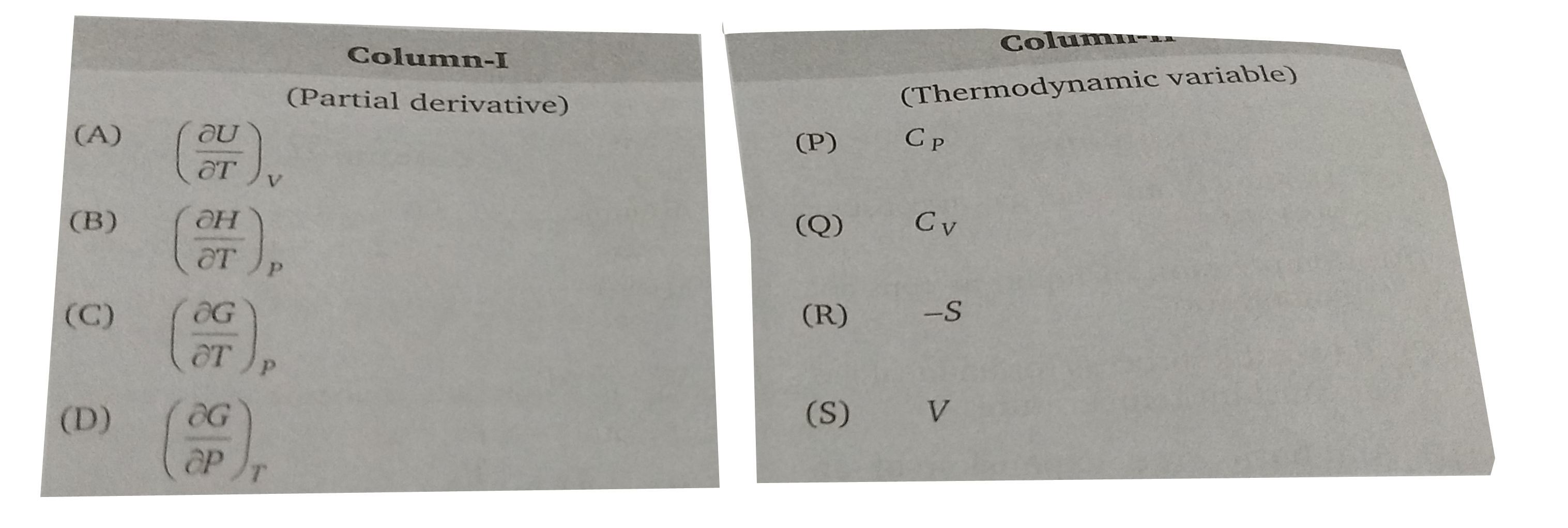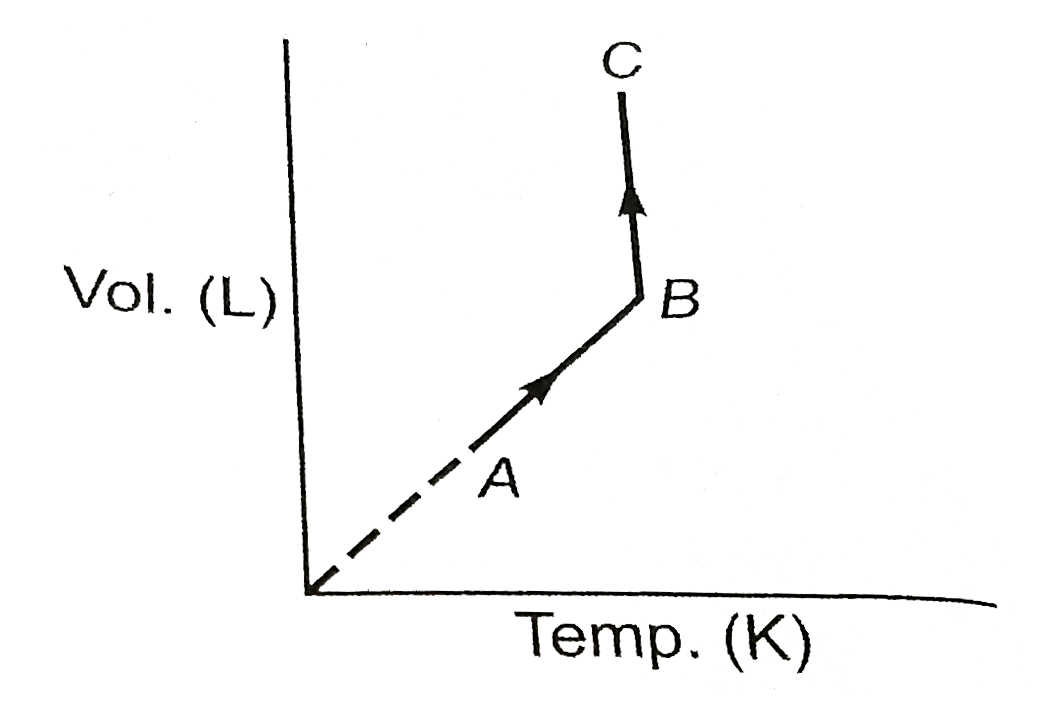Assume ideal gas behaviour for all the gases considered and neglect vibrational degrees of freedom. Separate equimolar sample. Separate equimolar samples of Ne, O2 , CO2 and SO2 were subjected to a two process as mentioned. Initially all are at same state of temperature and pressue.
Step I → All undergo reversible adiabatic expansion to attain same final volume, which is double the original volume thereby causing the decreases in their temperature.
Step → After step I all are given appropriate amount of heat isochorically to restore the original temperature.
Mark the correct option(s) : Solution in Telugu
Due to step I only, the decrease in temperature will be maximum for Ne
During step II, heat given will be minimum for SO2
There will be no change in internal energy for any of the gas after both the steps of process are competed
The P-V graph of O2 and CO2 will be same
The correct Answer is:A, C, D
First step is adiabatic (q = 0) so ΔU1=w1
Second step is isochoric (w = 0)

So, ΔU2=q2
∵ initial and final temp. are same
∴ ΔUtoal=ΔU1+ΔU2=0
or w1+q2=0
Max. work done by the gas, SO2 is (area) under the curve
so, SO2 absorbed
∵ γSO2<γCO2=γO2=<γNe
so, max. decrease in temp. of Ne due to step 1.
Topper's Solved these Questions
- BOOK - NARENDRA AWASTHICHAPTER - THERMODYNAMICSEXERCISE - Level 3 - Match The Column2videos
THERMODYNAMICS
- BOOK - NARENDRA AWASTHICHAPTER - THERMODYNAMICSEXERCISE - Level 2 (Q.1 To Q.30)1videos
THERMODYNAMICS
- BOOK - NARENDRA AWASTHICHAPTER - STOICHIOMETRYEXERCISE - Level 3 - Subjective Problems20videos
STOICHIOMETRY
Similar Questions
Match the following columns
 03:57View Solution
03:57View SolutionTwo moles of a triatomic linear gas (neglect vibration degree of freedom) are taken through a reversible process ideal starting from A as shown in figure.
The volume ratio VBVA=4. If the temperature at A is −73∘C, then :

(ii) Total enthalpy change in both steps is :04:36View SolutionWhat volume of a liquid (in L) will contain 10 mole ? If molar mass of liquid is 280 and its density is 1.4 g/mL.
10:18View SolutionA sample of ideal gas undergoes isothermal expansion in a reversible manner from volume V_(1) to volume V_(2) . The initial pressure is P_(1) and the final pressure is P_(2) . The same sample is then allowed to undergoes reversible expansion under adiabatic conditions from volume V_(1) to V_(2) . The initial pressure being same but final pressure is P_(2) . The work of expansion in adiabatic process (w_(adi)) is related to work of expansion in isothermal process (w_(iso)) is
03:05View SolutionInitial volume of three samples of same gas A, B and C are same. The process A is adiabatic, B is isobaric and C is isothermal. Each of the sample has same final pressure and volume. The initial pressure of which sample was maximum.
View SolutionIf separate samples of argon, methane, nitrogen and ammonia, all at the same initial temperature and pressure and expanded adiabatically to double their original volumes, then which one of these gases will require the greatest quantity of heat to restore the original temperature?
View SolutionThree samples of the same gas A,B and C (γ=3/2) have initially equal volume. Now the volume of each sample is doubled. The process is adiabatic for A. Isobaric for B and isothermal for C. If the final pressures are equal for all three samples, find the ratio of their initial pressures
10:18View SolutionAssume ideal gas behavior for all the gases considered and vibratonal degree of freedom to be active. Separated equimolar sample of Ne,O_(2), So_(2) and CH_(4) were subjedted to a two step process as mentioned . Initiallyt all are at same state of temperture and pressure. Step -I: All undergo reversible abiabatic expansion to attain same final volume thereby causing the decreasae in their temperature. Step -II : After step I, all are given appropriate amount of heat isochorically to restore the original temperature . Mark the correct optoin(s).
04:37View SolutionAssume ideal gas behaviour for all the gas considered & vibrational degrees of freedom to be active.
Separated equimolar sample of He,H2,SO2&CH4 were subjected to a two step process as mentioned.
Initially all are at same state of tempreature & prssure.
Step-I → All undergo reversible adiabatic expansion to attain same final volume, which is
double the original volume thereby causing the decreases in their temperature .
Step -II → After step I all are given appropriate amount of heat isochorically to restore the
Mark the correct option(s).05:01View SolutionAssume ideal gas behaviour for all the gases considered and neglect vibrational degrees of freedom. Separate equimolar samples of Ne, O_(2), CO_(2) and SO_(2) were subjected to a two process as mentioned. Initially all are at same state of temperature and pressure Step I rarr All undergo reversible adiabatic expansion to attain same final volume, which is double the original volume thereby causing the decreases in their temperature Step II rarr After step I all are given appropriate amount of heat isochorically to restore the original temperature Mark the correct option(s)
View Solutionएक ही गैस (γ=3/2) के तीन नमूनों A, B एवं C के प्रारंभिक आयतन समान हैं। अब प्रत्येक नमूने का आयतन दोगुना कर दिया जाता है, A के लिए प्रक्रम रुद्धोन, B के लिए समदाबी एवं C के लिए समतापी है। यदि तीनों नमूनों के अन्तिम दाब समान हैं, तब इनके प्रारम्भिक दाबों का अनुपात होगा
03:52View Solutionस्वतंत्रता की कम्पन्न कोटि को नगण्य मानते हुए तथा सभी गैसों के लिए आदर्श गैस व्यवहार की कल्पना करें। Ne,O2,CO2 तथा SO2 के समान मोलर नमूनों को पृथक करते हुए दी गई दो प्रक्रिया से गुजारा जाता है। प्रारम्भ में सभी ताप तथा दाब की समान अवस्था पर हैं
प्रथम चरण → सभी उत्क्रमणीय रूद्धोष्म प्रक्रम से होते हुए अंतिम आयतन प्राप्त करते हैं जोकि मूल आयतन का दुगुना होता है, उसके द्वारा तापक्रम में कमी उत्पन्न होती है
द्वितीय चरण → प्रथम चरण के पश्चात् सभी को समआयतनिक ऊष्मा की उपयुक्त मात्रा, मूल ताप को पुनः स्थापित करने के लिए दी जाती
सही विकल्प (विकल्पों) को चिन्हित् कीजिए05:50View SolutionThree samples of the same gas A, B and C (gamma = 3//2) have equal volume initially. Now, the volume of each sample is doubled. For A, the process is adiabatic , for B, it is isobaric and for C, the process is isothermal. If the final pressures are equal for all the three samples, the ratio of their initial pressures is
04:28View SolutionAssume ideal gas behaviour for all the gases considered and neglect vibrational degrees of freedom. Separate equimolar sample. Separate equimolar samples of Ne, O_(2) , CO_(2) and SO_(2) were subjected to a two process as mentioned. Initially all are at same state of temperature and pressue. Step I rarr All undergo reversible adiabatic expansion to attain same final volume, which is double the original volume thereby causing the decreases in their temperature. Step II rarr After step I all are given appropriate amount of heat isochorically to restore the original temperature. Mark the correct option(s) :
View Solutionआदर्श गैस के समान आयतन वाले दो नमूनो को पृथक-पृथक समतापीय प्रक्रम और रूद्धोष्म प्रक्रम द्वारा उनके प्रारम्भिक आयतन का आधा कर दिया जाता है, तो
View SolutionThree samples of the same gas A,B and C (γ=3/2) have initially equal volume. Now the volume of each sample is doubled. The process is adiabatic for A. Isobaric for B and isothermal for C. If the final pressures are equal for all three samples, find the ratio of their initial pressures
04:28View Solution

